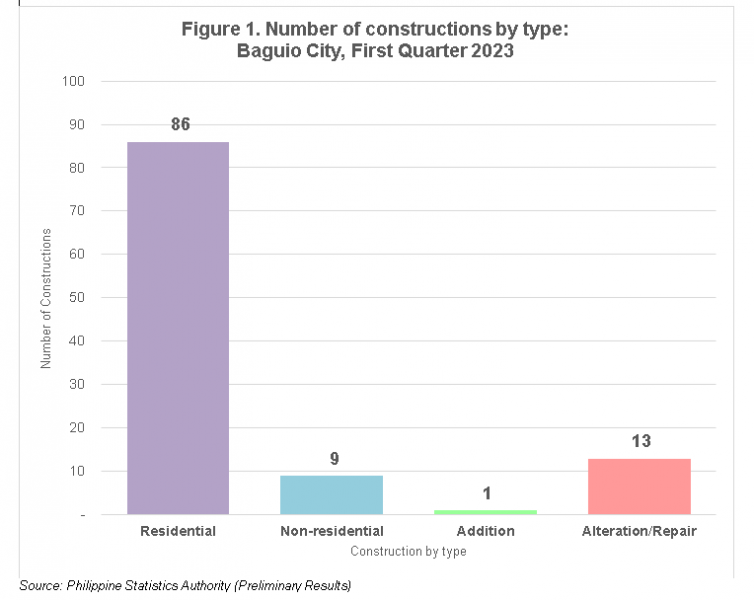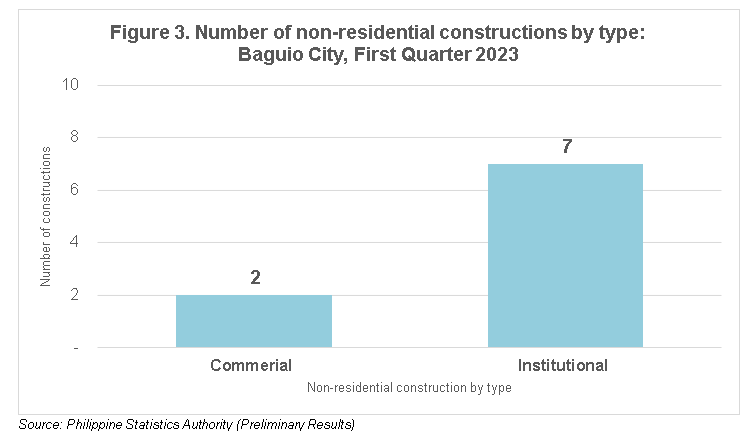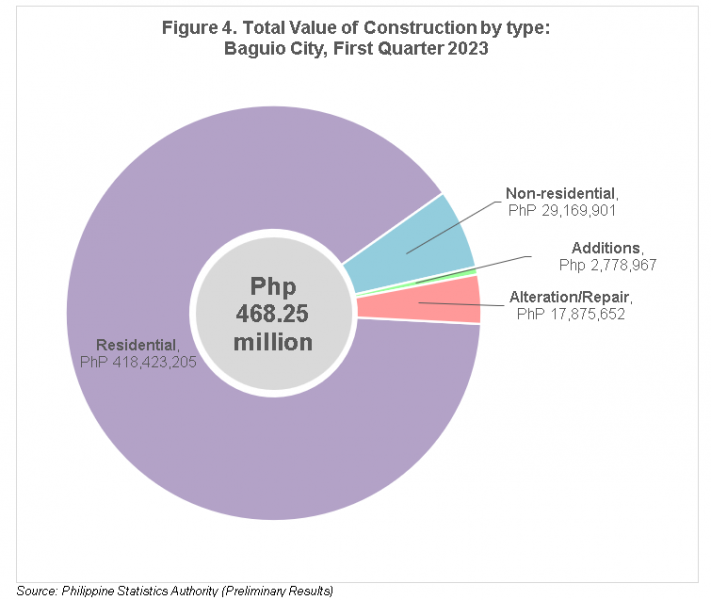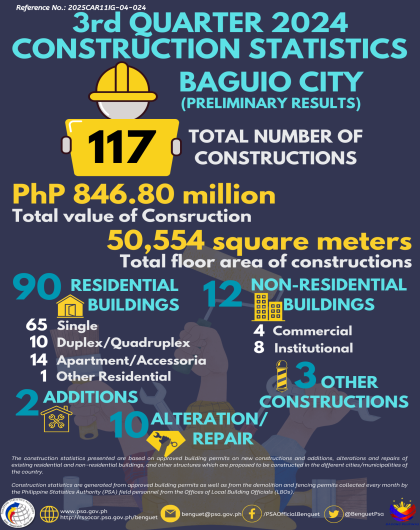109 constructions in Baguio City in the first quarter of 2023
The approved building permit applications in Baguio City for the first quarter of 2023 recorded a total of 109. Residential buildings recorded the highest number of constructions with a total of 86. There were 13 building alterations/repairs done, nine non-residential building constructed, and one building addition. (Figure 1)

By type of residential buildings constructed, single house recorded the highest with 60 constructions. This was followed by apartment/accessoria with 20 constructions, duplex/quadruplex house with four constructions and other residential buildings with two constructions. (Figure 2)

By type of non-residential buildings constructed, institutional building recorded seven constructions and commercial building recorded two constructions. (Figure 3)

Total value of construction amounts to PhP 468.25 million
The total value of construction from approved building permits in Baguio City for the first quarter of 2023 was recorded at PhP 468.25 million. Residential buildings recorded the highest value of construction at PhP 418.42 million. This was followed by non-residential constructions with PhP 29.17 million, alteration/repair with PhP 17.88 million, and building addition with PhP 2.78 million. (Figure 4)

Average cost per square meter of residential building is PhP 14,219.99
The total floor area of residential buildings constructed is 29,425 square meters. This translates to an average cost of PhP 14,219.99 per square meter.
For single house, the total floor area constructed is 15,445 square meters with an average cost of PhP 14,314.29 per square meter. Duplex/quadruplex houses constructed have a total floor area of 1,729 square meters with an average cost of PhP 9,109.06 per square meter. Apartment/accessoria constructed recorded a total of 9,764 square meters with PhP 14,254.57 average cost per square meter. Other residential constructions had a total of 2,487 square meters with PhP 17,051.78 average cost per square meter.
Average cost per square meter of non-residential building is PhP 13,337.86
The total area of non-residential buildings constructed is 2,187 square meters. This translates to an average cost of PhP 13,337.86 per square meter of the non-residential buildings constructed.
For commercial buildings, the total floor area constructed is 202 square meters with an average cost of PhP 20,906.03 per square meter. Institutional buildings constructed have a total floor area of 1,985 square meters with an average cost of PhP 12,567.70 per square meter.
IMELDA L. BUYUCCAN
Chief Statistical Specialist
/DJPN
-----
TECHNICAL NOTES
Introduction
This Special Release presents the preliminary data on construction statistics from approved building permits for the first quarter of 2023.
Scope and Coverage
Construction statistics presented in this special release are based on approved building permits on new constructions and additions, alterations and repairs of existing residential and non-residential buildings, and other structures which are proposed to be constructed in the different cities/municipalities of the country.
Sources of Information
Construction statistics are generated from approved building permits as well as from the demolition and fencing permits collected every month by the Philippine Statistics Authority (PSA) field personnel from the Offices of Local Building Officials (LBOs).
Limitations of data
1. Data on building constructions are based on approved applications for construction during the reference period and not on the construction work completed during the reference period.
2. The completeness of construction data relies on the approved applications filed with the LBOs. Hence, building constructions without approved building permits are not part of the tabulation of data.
Geographic Classification
Building constructions are classified and presented by geographic area using the Philippine Standard Geographic Classification (PSGC) as of December 2021.
Statistics Generated
Construction statistics generated from approved building permits provide monthly data on building construction at the regional and provincial level. The statistics generated are the following:
1. number
2. floor area
3. type of construction
4. value of construction
Definition of Terms
Building permit is a written authorization granted by the LBO to an applicant allowing him to proceed with the construction of a specific project after plans, specifications and other pertinent documents have been found to be in conformity with the National Building Code (PD 1096).
Building refers to any independent, free-standing structure comprised of one or more rooms or other spaces, covered by a roof and enclosed with external walls or dividing walls, which extend from the foundation to the roof.
Construction refers to all on-site work done from site preparation, excavation, foundation, assembly of all the components and installation of utilities, machineries, and equipment of buildings/structures.
Residential building is a building for which its major parts or more than half of its gross floor area is built for dwelling purposes. This type of building can be of the single type, duplex, apartment and/or accessoria, and residential condominium.
Single house is a complete structure intended for a single family or household, i.e., bungalow, 2-storey house, nipa hut, etc.
Duplex house is a structure intended for two households, with complete living facilities for each; it is a single structure divided into two dwelling units by a wall extending from the floor to the ceiling.
Apartment is a structure, usually of two storeys, made up of independent living quarters, with independent entrances from internal walls and courts.
Accesoria is a one or two-floor structure divided into several dwelling units, each dwelling unit having its own separate entrance from the outside.
Residential condominium is a structure, usually of several storeys, consisting of multiple dwelling units.
Other residential construction consists of school or company staff houses, living quarters for drivers and maids, and guardhouses.
Non-residential building includes commercial, industrial, agricultural and institutional buildings.
Commercial buildings refer to office buildings and all buildings which are intended for use primarily in wholesale, retail and service trades; i.e., stores, hotels, restaurants, banks, disco houses, etc.
Industrial buildings are buildings used to house the production, assembly, and warehousing activities of industrial establishments; i.e., factories, plants, mills, repair shops, machine shops, printing press, storage plant, electric generating plants.
Institutional buildings are buildings which primarily engaged in providing educational instructions and hospital/health care; ports, airports and other government buildings; i.e., school, museums, libraries, sanitaria, churches, hospitals.
Agricultural buildings are buildings used to house livestock, plants, and agricultural products such as barn, poultry house, piggeries, stables, greenhouses, and grain mill.
Other non-building constructions include cemetery structures, street furniture, waiting sheds, communication towers, etc.
Addition refers to any new construction which increases the height or area of an existing building/structure.
Repair is a remedial work done on any damaged or deteriorated portion/s of a building/structure to restore its original condition.
Renovation is any physical change made on structures to increase their value and quality.
Alteration is a construction in a building/structure involving changes in the materials used, partitioning and location/size of openings, structural parts, existing utilities and equipment but does not increase the overall area thereof.
Conversion is a change in the use or occupancy of structure or any portion thereof, which has different requirements.
Demolitions refer to the systematic dismantling or destruction of a building/structure, in whole or in part.
Street furniture are street structures consisting of monuments, waiting sheds, benches, plant boxes, lampposts, electric poles, and telephone poles.
Floor area of building refers to the sum of the area of each floor of the building measured to the outer surface of the outer walls including the area of lobbies, cellars, elevator shafts and all communal spaces in multi-dwellings. Areas of balconies are excluded.
Total value of construction refers to the sum of the cost of building, electrical, mechanical, plumbing, and others. The value is derived from the approved building permit and represents the estimated value of the building or structure when completed.


